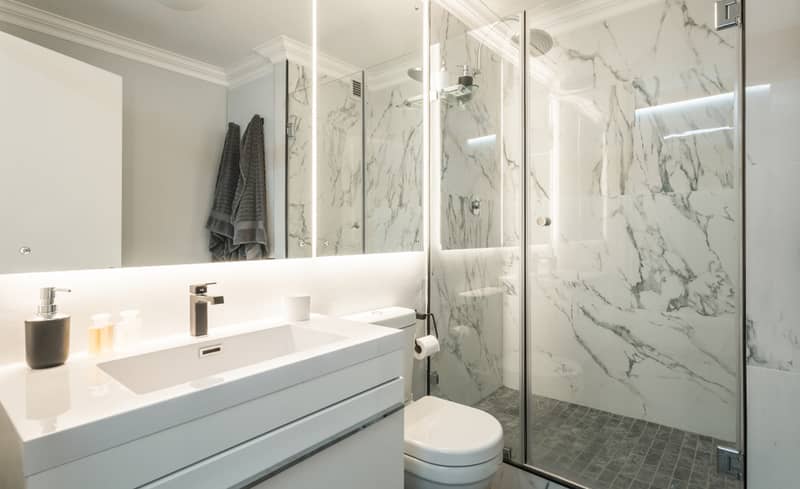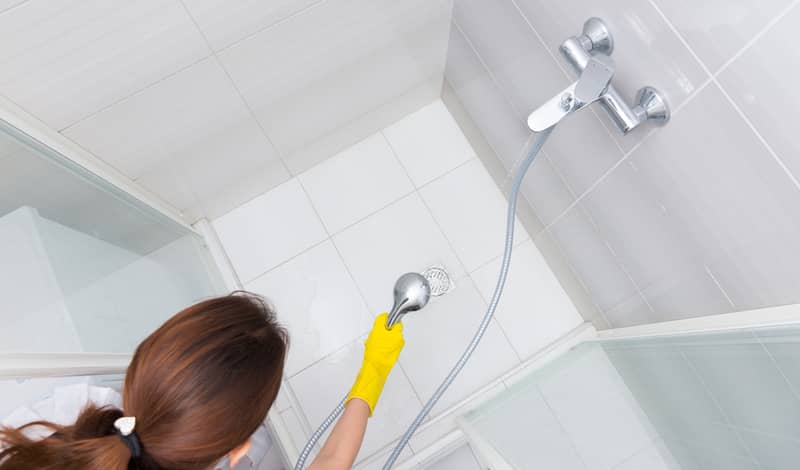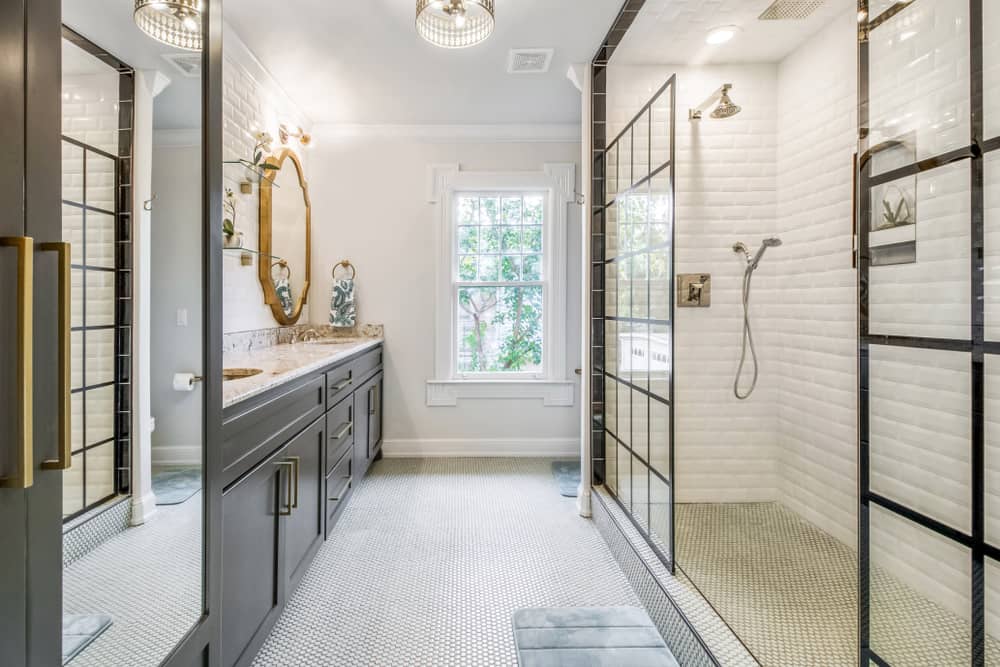We talk a lot about cleaning the bathroom, from washing the shower head to wiping down the mirror. One other area we may neglect for more pressing issues is the floor – especially the shower floor.
How to clean shower floors? It depends on the material.
- Clean ceramic or porcelain using vinegar, dish soap, and water
- Clean natural stone with non-acidic dish soap and water, or specialised cleaners
- Clean plastic like vinyl or linoleum with soapy water
- Clean terrazzo with dish soap and water, or a rubbing alcohol and detergent mix
- Clean fibreglass with non-abrasive cleaners like a mild detergent or white vinegar
- Clean wood (like hardwood or bamboo) with pH-neutral soap and water
For most materials except wood, you can also use a thin baking soda paste to scrub off stains. Then make sure to thoroughly rinse the floor before wiping off any excess moisture. Finally, let the floors air dry.
Floors can make or break the appearance of any room, even your bathroom. So grab a mop and switch on your favourite playlist – and prepare to be floored by the results.
Why Clean a Shower Floor?

Much as we’d wish that the water would wash everything away, over time, you will get a dirty shower floor.
Things like soap scum, body oil, and mineral deposits build up after every shower. It’s essential to clean the shower (from head to floor) to keep things hygienic.
Otherwise, you could risk mould and mildew – and a dirty-looking bathroom.
How Often to Clean Shower Floors
You should clean the floor when you clean the shower – so once a week!
Keep a squeegee and squeegee mop handy in your shower to wipe off excess water and dirt after showers (or at the end of the day).
Different Shower Floor Materials
Whenever you think of a bathroom, you probably imagine the typical tiles – but there are lots of materials for shower walls and floors.
And the material will determine how to clean tiles, as some materials are more sensitive than others!
- Ceramic or porcelain tile is the most common material for household showers. It’s durable and easy to clean.
- Natural stone floors are usually made of granite, marble, or onyx. Stone is porous, so the material must be sealed to make it water-resistant. Some designers use pebbles instead of solid stone tiles.
- Plastics usually come in vinyl or linoleum, which are budget-friendly and fairly waterproof. However, they’re vulnerable to mould and water damage.
- Terrazzo is a composite material of chips and bits from marble, granite, quartz, shells, etc. It’s poured into a cement or epoxy base and sealed for waterproofing.
- Fibreglass is a prefabricated material made from plastic reinforced with glass fibres. It’s inexpensive but can crack easily.
- Wood is a timeless choice, but must be laminated or prefinished to make the wood water-resistant. Bamboo is becoming a popular choice as it’s eco-friendly, durable, and more moisture-resistant.
Before Cleaning a Shower Floor

Gather the right cleaning supplies in a caddy or similar carrying container. That’ll make it easier for you to work since everything’s in one place.
Check how dirty the floor is – soap scum and water spots are more straightforward to tackle. On the other hand, cleaning mould in the shower will take much more elbow grease.
If it feels like too big a job for you, or if you’d rather not spend an afternoon scrubbing tiles, check out reputable pro cleaners in your area. They’ll tackle your bathroom (and everything else) for you!
Before touching any products, start by sweeping your bathroom floors. A vacuum cleaner would be too clunky in the small space (and might damage the floor material), so sweeping is better.
Go along the edges and work towards the centre. Don’t forget to reach behind fixtures like mirrors, cabinets, and toilets!
How to Clean Ceramic or Porcelain Shower Floors
To clean shower floor tiles and grout lines, you can use your preferred shower cleaner or multi-purpose cleaner.
For an eco-friendly option, try Koala Eco’s Multi-Purpose Bathroom Cleaner.
Alternatively, you can go DIY with one of our favourite ways to clean tiles. Simply mix half a cup of white vinegar per litre of water in a bucket, then add a tablespoon of dish soap.
Dunk a mop in the mixture, then wring out the excess. Go back and forth over the tiles, working from the corner furthest from the door.
Rinse the mop frequently, and change the cleaning solution when it becomes dirty.
Wash the residue off with clean water, then dry with a fresh towel or mop.
Clean the tile grout with a 2:1 paste of baking soda and hydrogen peroxide and a scrub brush or old toothbrush. Alternatively, use a steam cleaner with a grout tool.
You can also try to clean shower floors without scrubbing with that same baking soda paste above. Apply the mixture with a mop or sponge, and leave it for an hour.
Rinse the tiles with warm water, then air dry.
How to Clean a Natural Stone Floor

Stone is a porous material, so it absorbs soap scum and moisture. You’ll need to regularly seal stone floors or the material could develop stains or mould.
Do not use traditional products such as a multi-purpose cleaner – these will be too harsh for delicate stone. You may end up discolouring or damaging the floor.
Avoid any products that are too acidic as well, such as vinegar or lemon juice.
Instead, to clean a natural stone shower floor, simply use a mix of warm water and mild dish soap. You can add some baking soda for a bit of scrubbing action to remove soap scum or hard water deposits.
Rinse the floor with fresh water, then let the space air dry or mop it up with a clean towel.
Alternatively, use a specialised stone cleaner such as Black Diamond Stoneworks Floor Cleaner or Granite Gold Floor Cleaner.
How to Clean a Plastic Shower Floor
Plastic flooring is often also called “resilient” tiles or flooring – which includes linoleum and vinyl. Plastic shower floors are low-maintenance and easy to clean.
To clean a vinyl shower floor, mix a cup of vinegar in a litre of water. Use a mop to apply the solution onto the entire shower floor.
To clean a linoleum shower floor, add a bit of borax (or borax detergent) to water. Use a sponge or mop to wash the floor with the solution.
You can use a soft-bristled brush to dig into and scrub off tough stains or grime.
Rinse the floor with fresh water. Then let the floor air dry or remove moisture with a dry mop or towel.
Do not use a steam mop on a plastic shower floor as the heat will warp the material.
How to Clean Terrazzo Shower Floor

A terrazzo shower floor needs to be regularly sealed (once a year) to maintain water and stain resistance.
To clean your terrazzo shower floor, use a similar solution to natural stone – a mix of warm water and mild, non-acidic dish soap.
Use a mop or a soft scrub brush to apply the mixture onto the tiles. You can rinse right away, or let the solution sit for a few minutes for extra cleaning power.
For stains or hazy spots on your terrazzo shower floor, mix 1/4 cup rubbing alcohol, 1/4 tsp dish soap, and 2 cups warm water in a spray bottle.
Lightly saturate the affected area, then let it sit for up to 3 minutes. Wipe the cleaner off with a damp cloth or sponge in circular motions.
Dry the terrazzo tile with a soft cloth.
How to Clean a Fibreglass Shower Floor
Avoid using abrasive cleaners for fibreglass – whether that’s shower doors or the floor.
Instead, use a mild detergent or gentle all-purpose cleaner. Opt for soft sponges or soft-bristled brushes – never steel wool or hard bristles.
Mix the mild detergent with some lukewarm water and apply it to the floor using a microfiber cloth or mop. Gently work the cleaner over the surface, then rinse off.
For soap scum and other stains, gently scrub the fibreglass with a thick paste of baking soda and water. Alternatively, spray on a little white vinegar and buff with a soft cloth.
Rinse off any residue afterwards.
How to Clean a Wood Shower Floor

When cleaning a wood floor (whether hardwood or bamboo) you’ll want to minimise moisture. Wring out any mops or cloths before wiping.
Use a pH-neutral detergent or specialised product like Bona Wooden Floor Cleaner.
Add a bit of mild detergent to water in a bucket, then dip a microfibre cloth or mop into the solution. Wring it out so the cloth is just damp, then use that to wash the floor.
Use circular motions, and work in small sections at a time. Rinse the mop out frequently, then keep going until the floor is clean.
Let the floor air dry or use a clean towel to wipe off the remaining moisture.
How to Remove Mould from a Shower Floor
For ceramic/porcelain and plastic floors, you can start by spraying the mouldy area with undiluted white vinegar. Leave it to sit for 20-30 minutes, then gently scrub with some baking soda and an old toothbrush.
For more severe cases of mould, use diluted oxygen bleach. Always wear protective equipment such as rubber gloves.
If there is mould or mildew on stone, terrazzo, fibreglass, or wood floors, you’ll need to consult a professional.

How to Remove Stains on a Shower Floor
These methods mostly apply to ceramic/porcelain, plastic, and fibreglass shower floors. Stone and wood will require more specialised cleaners.
Tackle tough stains on a shower floor with a paste of baking soda and hydrogen peroxide. Apply the cleaning solution with a sponge, then let it sit for a few minutes.
Begin scrubbing with a soft-bristled brush or toothbrush, then rinse the residue off.
Alternatively, for rust stains, sprinkle some salt on half a lemon. Use that to scrub the rust off, then rinse the affected area.
Cleaning Tips for Essential Shower Maintenance
Keep a squeegee and/or squeegee mop and a spray bottle of vinegar in your shower stall. This will help minimise the build-up of soap residue and hard water deposits in between deeper cleaning.
You can use the squeegee on all materials for shower doors and floors. However, only use vinegar for ceramic, porcelain, plastic, or fibreglass.
Never mix cleaning products since that would result in hazardous reactions. For example, you cannot mix bleach with anything except water.
Always work in a well-ventilated room – open windows, doors, and exhaust fans. Wear protective equipment as well, including rubber gloves and a face mask.
Make sure to get into all the corners and crevices. This goes double for a shower stall in an unusual shape – more corners mean more cleaning.
When cleaning the shower, work from top to bottom. Start with the shower head and walls. Give any caddies or shelfs a quick scrub. Follow that with the shower floor.
Once those are done, go ahead and clean the shower drain as well. Then finish off with the rest of your shower… and reward yourself for a job well done.

